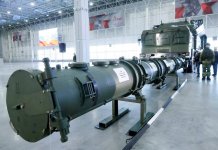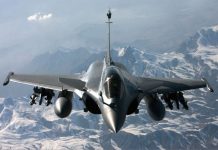India is the main ally of the United States in the fight against Chinese expansion in the Indo-Pacific region; however, trade disputes and proximity to US’ adversaries Russia and Iran hinder partnership between India and the United States.
India a Vital Cog in the Wheel For US’ Strategy For Indo-Pacific Region
India gained access to nuclear materials and technology and the most modern weapons and military equipment from the United States. In Washington, India is often called the “main defence partner” and the cornerstone of American strategy in Asia. Whether India wants to be a key cog in the wheel in the US strategy in Asia against China is not yet clear, but one thing is clear that India wants to further its regional and global ambitions using all possible shoulders including that of the US, Russia, Japan, EU and China. A EurAsian Times analysis.
Donald Trumps Meets Narendra Modi
The G20 summit in Osaka saw an abundance of bilateral meetings between the leaders of the twenty most developed countries on the planet. Many met on the sidelines of the summit with the president of the US – Donald Trump, who was surprisingly friendly and talkative.
Indian Prime Minister Narendra Modi also met Trump and US President emphasized that relations between the US and India had never been as good as they are now. Trump stressed that Washington and Delhi are waiting for “very big” deals in trade.
According to the Secretary of the Ministry of Foreign Affairs of India, Vijay Gokhale, Modi and Trump discussed Iran, the development of 5G networks, trade and relations in the field of defence.
On Iran, both the parties agreed to continue to strengthen stability in the region. Narendra Modi shared energy problems with the United States, which aroused after New Delhi reduced imports of Iranian oil, which provided about 11% of India’s fuel needs.
Modi agreed that India, which has a billion users, needs to cooperate with the United States in the development of 5G networks, but did not say a word about Washington’s request to stop cooperating with the Chinese telecommunications giant Huawei.
The leaders of the first and fifth largest economies of the world stated that they had ordered their trade ministers to sit down as quickly as possible at the negotiating table and resolve the differences in trade.
In regard to relations in the field of defence, the discussion of military issues was very short due to lack of time. Washington and Delhi are doing well in matters of defence, although there are problems in this area too. In general, Vijay Gokhale said, Trump and Modi’s meeting in Osaka was “very productive.”
Mike Pompeo: Disagreements Between Close friends Not Uncommon
The above statement was said a few days before the G20 summit at the joint press conference in Delhi by the Indian and US foreign ministers Subrahmanyam Jaishankar and Mike Pompeo. Pompeo visited the Indian capital on the way to Osaka after visiting Saudi Arabia, the United Arab Emirates and Afghanistan, where he tried to convince the leaders of these countries to join the anti-Iranian coalition.
The Secretary of State acknowledged the existence of contradictions but expressed the hope that they would be overcome. He called India and the United States “friends who can help each other across the planet.”
“There may well be disagreements among close friends,” the secretary of state explained to reporters. “The United States made it clear that they want greater access to the Indian market and are counting on the removal of barriers to trade.”
The visit of Pompeo, the first senior US official after Modi’s re-election, took place in an atmosphere of heightened controversy. India and the United States call each other strategic partners and at the same time imposed tariffs on each other leading almost to a trade war.
Another irritant for US-Indian relations is Delhi’s intention to buy Russian S-400 Triumph anti-aircraft missile systems. Some political analysts do not exclude the possibility that the S-400 missile deal and robust defence cooperation between India and Russia could become a graveyard for US-Indian ties.
Jayshankar said both the parties discussed cooperation in the defence sphere, but he pointedly emphasized that Delhi was guided in its policy of national interests. Despite the expansion and deepening of military cooperation with the United States, Delhi does not want to break a long-standing defence partnership with Russia.
My trip to Saudi Arabia, UAE, Afghanistan, India, Japan, and ROK strengthened our partnerships across many critical issues. I was also honored to accompany President @realDonaldTrump at his historic visit to the DMZ, where he became the first U.S. President to step into DPRK. pic.twitter.com/lYV0Tj0q8M
— Secretary Pompeo (@SecPompeo) June 30, 2019
In terms of Iran, New Delhi, after much deliberation and hesitation, virtually completely stopped buying oil from Tehran. Nonetheless, throughout May and June, in the midst of growing tensions between Tehran and Washington, Indian diplomats continued to work on renewing the permission to import Iranian oil. Delhi understands America’s concern on Iran, but for India, a complete rejection of Iranian oil is a terrible blow to the economy. Indian foreign minister S.Jaishankar believes that energy supplies across the globe should remain stable, predictable and affordable.
Just like Trump, Pompeo showed his Indian counterpart and “carrot” – he mentioned the prospect of huge American investments and said that “trillions of dollars of US investments were awaiting the Indo-Pacific region”.
Deceptive “Softness”
In order to understand the complexities of relations with India of any country, including, of course, the United States, it is necessary to understand that it is not for nothing that they call it a country of mysteries and secrets.
For example, for many years among political scientists it was widely believed that India despite its vast territory, population and resources is a weak strategic player. This theory, it would seem, was confirmed by the history of India, which for many centuries was captured by the conquerors, who possessed considerably less power than the Indians themselves.
Not surprisingly, Washington Post commentator Bernard Nossiter called India a “weak state”, unable to muster the political will to resist external challenges and threats. Experts have been talking for many years about Delhi’s “soft” approach to security issues, about “moralistic” foreign policy, based, for the most part, not on security considerations, but on ethical considerations.
However, this theory has many flaws. In all the six wars that were imposed on India, New Delhi acted quite energetically and was overwhelmed only once – in the war with China in 1962. In four of the five remaining major military conflicts, India achieved a decisive victory, although it did not derive any special benefits from them. This circumstance, obviously, caused the emergence of an erroneous theory about the “softness” of India.
In any case, even the proponents of this theory do not argue that current India, from the point of view of security, doesn’t resemble India in the times of Nehru and Gandhi. And the extremely sharp reaction to the terrorist attack in Pulwama, Kashmir is a convincing confirmation of this conclusion.
United States and India in the Indo-Pacific Region
On June 1, 2019, the Pentagon published the “Strategy in the Indo-Pacific Region”, which supplemented Trumps “Strategy of the Free and Open Indo-Pacific Region”. An important place in the report is occupied by relations between the United States and India, which, according to the authors, “are built on mutual interests, democratic values and strong ties between people.”
The turn towards the United States in a pro-Soviet India occurred after the end of the Cold War. After the collapse of the USSR and the indirect message from Moscow that Russia could no longer provide security for India, Delhi began to turn towards the United States. Here, the fact that the end of the Cold War and the loss of the defender and patron in the face of the USSR coincided with the beginning of the rapid growth of China’s power, both economic and military, played a role.
The first official agreement on joint defence between Delhi and Washington was signed in 1995. During the second Bush administration, the parties expanded their relations, focusing on mutual interests: counterterrorism, nuclear cooperation and combating China’s growing influence. In 2016, the Obama administration called India “the main defence partner and one of America’s closest allies.
Last year, the Trump administration launched a dialogue in the 2 + 2 format, during which an Agreement on Compatibility of Communication and Security (COMCASA) was signed, the second of three logistics agreements that expand and deepen cooperation and information exchange between the two countries.
American and Indian leaders often call their countries “natural partners” who share the same values and who share the main strategic interests. For the last quarter of a century, India and the US are really moving towards each other, according to the Financial Times (FT), and deepening defence cooperation.
Proponents of rapprochement between the United States and India, not without reason, hoped that rapprochement would accelerate under Donald Trump, who had repeatedly called himself “a big, big fan” of India during the election campaign.
The inclusion of “major defence partners” – agreements were signed on the use of each other’s military and military infrastructure by the US and Indian forces, as well as on the exchange of important information on military matters.
Last year, the Pentagon, obviously wanting to please New Delhi, changed the name of the Pacific Command to Indo-Pacific. India’s purchases of American weapons and military equipment are growing, and joint exercises are increasingly being conducted.
Disagreements between India and United States
Relations between India and the United States are developing incrementally, but not without problems. There are a lot of disagreements, ranging from deep-rooted Indian protectionism and unpredictable policies to regulate the activities of foreign companies and Delhi’s desire to buy Russian S-400 missiles. According to many analysts, these differences are intensifying and may well undermine the strategic cooperation between countries.
Washington considers India a critical element of a long-term security strategy in Asia, based on defence cooperation between Japan, Australia, the United States and India to counter China’s growing influence in the region.
As in any relationship, there are problems and there are quite a few problems between the US and India. The United States wants to end Delhi’s long-standing ties with countries such as Iran and Russia and India expectedly is not relenting.
The United States is pushing India to give up on Iranian oil. However, this approach does not take into account the existence of centuries-old cultural, linguistic and trade relations between India and Iran. It is not by chance that Persian literature, poetry, painting, and architecture are closely intertwined with Indian society.
India’s ties with Russia go back to the Cold War, when they had a common position on many issues, although they were not formal allies. Washington is very wary of India’s continued dependence on Russian weapons especially the S-400 anti-aircraft missile systems. The United States fears that continuing sales of Russian weapons will affect the development of US-Indian relations and impact the US defence industry. In addition, the trade in Russian weapons violates the Law on Countering America’s Opponents through Sanctions (CAATSA).
US-India Trade Relations
Another Achilles heel is trade. American business sees India as a very profitable market with 1.3 billion consumers. However, US businessmen are extremely unhappy with Indian protectionism and unpredictable policies, which makes India a country where it is difficult to do business. Over the past decade, bilateral trade has more than doubled: from $ 66 billion in 2008 to $ 142 billion in 2018. However, Donald Trump is not satisfied. He is, for example, very annoyed by the 24 billion deficit in trade with India.
The White House is particularly dissatisfied with the restrictions imposed by Delhi on medical equipment and animal products from the United States on the participation of foreign companies in electronic commerce. Personally, Trump repeatedly complained on Twitter about 50% of the tariffs for Harley-Davidson motorcycles.
The logical question is, what is stronger: strategic cooperation or trade? The question is not at all rhetorical, given that President Trump still remains more of a businessman than a politician.
Contradictions in trade, meanwhile, deepen. Washington recently cancelled the preferential trade agreement for India. As an explanation, Trump cited Delhi’s reluctance to open the Indian market to American companies.
India responded with the introduction of tariffs on 28 American goods worth $ 1.4 billion, which, by the way, is four times less than the loss of Indian business. US tariffs for Indian goods from June 1 are approximately $ 6.3 billion. From now on, the average tariff for goods from the US in India is 6.94%, which is slightly higher than the US 6.01% and Chinese 6.06%, according to the World Bank for 2017.
It seems that both the United States and India want to avoid escalating tensions, but things are not as easy as they appear to be. Washington, for example, at the end of June hinted that they intend to strictly demand Delhi’s permission for American IT giants to store information about Indian users abroad. The Indian government is no less determined to store data of Indian citizens in India only.
Rumour has it that Washington may begin a formal investigation of the so-called unfair trade policy of India. Such an investigation, as shown by recent history with China, could lead to a full-scale trade war.
There are, of course, other serious differences. India appreciates the extensive good relations with dozens of countries. The White House and the US State Department are particularly unhappy with Delhi’s long-standing and strong ties with Moscow and Tehran, which for many years have been providing India with military equipment and oil.
In addition to the Iranian oil, the Americans are asking India to abandon Huawei equipment. Washington warned that if India continues to work with Huawei, it may affect their national security.
There is a danger that all this pressure from the United States may make India respond negatively to Washington as Indian people are very cautious about sovereignty and integrity. Trump was right when he said that now the relationship between the US and India is much better than in the past but on the other hand, he should remember and accept the fact that most Indians have not forgotten the principles of non-alignment and neutrality and should not expect New Delhi to change sides all of sudden.
Nitin Ticku is a MARCOM consultant and an analyst on international affairs. The views of the author are personal and may not necessarily reflect the views of the EurAsian Times. Nitin Ticku can be contacted at Nytten@Gmail.com.




